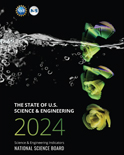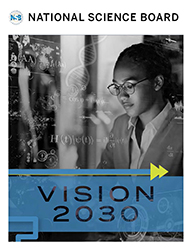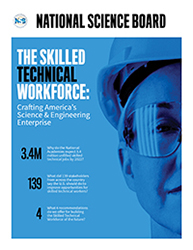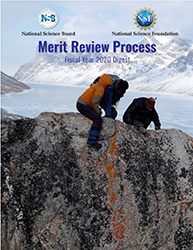
U.S. is a keystone of the world’s science and engineering ecosystem
Global S&E capacity grows as more nations increase investments in research and talent development

Indicators 2022: Publications Output (Credit and Larger Version)
January 18, 2022
In ecological science, a keystone species is essential to the entire ecosystem. Weaken or remove a keystone and it impacts everything else. The National Science Board’s The State of U.S. Science and Engineering 2022 published today, shows that for the world’s science and engineering (S&E) ecosystem, the U.S. is such a keystone. The U.S. bridges nations and geographic regions, connects demographic groups and disciplines, and links sectors together. These connections germinate the next breakthrough discoveries, growing them from imagination to impact. As one example, analysis of coronavirus-related publications in 2020 shows the centrality of the U.S. to the global research effort and the strong collaboration between the U.S. and researchers around the world, most notably China and the United Kingdom.
“As more nations participate in science and engineering, collaborations become more vital” says NSB Chair Ellen Ochoa. “In addition, a strong U.S. presence reinforces the core values of open, transparent and ethical conduct of S&E research.”
“This report confirms the urgent need to accelerate and strengthen U.S. science and technology progress,” says NSF Director Sethuraman Panchanathan. “The U.S. National Science Foundation is bringing together its partners to empower our nation’s STEM talent and unleash the full power of U.S. innovation and competitiveness on the most complex challenges facing society.”
While it’s clear that the U.S. is a nexus of global S&E, the data also point to urgent problems.
They include disparities in U.S. K-12 STEM education and student performance across demographic and socioeconomic categories and geographic regions, along with lack of affordability of higher education.
“Addressing the persistent educational inequities that exist across geography, race and ethnicity, and socioeconomic status is both an ethical and economic imperative for our country,” says Julia Phillips, Chair of NSB’s Science and Engineering Policy Committee. “To meet our workforce needs and ensure the U.S. remains globally competitive, we must break down the systemic barriers that too many Americans face and nurture the next generation of domestic STEM talent from K-12 through doctoral degrees.”
Elementary and secondary science and math education is the foundation for STEM knowledge, providing a pathway into S&E majors and subsequent careers. Access to experienced STEM teachers is an important factor in student performance. Indicators data show that less experienced STEM teachers are more prevalent among the Southern and Western regions of the U.S. and in schools with high minority enrollment or high poverty rates, revealing geographic, socioeconomic, and racial or ethnic disparities in STEM education. Internationally, in mathematics literacy, the U.S. ranks 25th of 37 countries included in the Organisation for Economic Co-operation and Development. This low U.S. international ranking in mathematics is consistent with the lack of improvement in U.S. student achievement for more than a decade. Compared to the majority of the nation’s largest S&E competitors, the U.S. places last in K-12 student science and math performance.
In higher education, financial barriers – particularly education-related debt – can be a significant obstacle to education and career advancement and contribute to Missing Millions in STEM. The average undergraduate charge at public four-year institutions as a percentage of disposable personal income increased from around 33% in the early 2000s to 41% in 2019.
In addition to developing domestic talent, America must also continue to welcome foreign talent, says Phillips.
“In degree fields that are vital to critical and emerging technologies, such as artificial intelligence and biotechnology, the U.S. must actively embrace equity in developing domestic talent,” says Phillips. “At the same time, America must continue to attract the talent from around the world that has long been – and will continue to be – essential to the U.S. economy and our S&E ecosystem.”
In computer science, mathematics, and engineering, nearly 60% of Ph.D. holders in the U.S. workforce are foreign-born.
“Ultimately,” says Phillips, “as a keystone of global S&E, the United States must be a place where all talent is given the opportunity, freedom, and resources to innovate, take risks, and collaborate. Our country must be a place where researchers can explore without knowing in advance what discoveries may result, but sure in the knowledge that the fruits of research will help solve societal challenges, deliver near-term innovations, and bring long-term benefits to Americans and all of humanity.”
Other Highlights
R&D: The U.S. leads the world in R&D spending. Growing from a very small base in 2000, China now is the second leading country in R&D spending. Together, the U.S. (27% of the global total), and China (23%), perform about half of global R&D.
Basic Research: The U.S. is still by far the biggest investor in basic research, outspending China three-fold. But the share of basic research the federal government funds is declining. This matters, says Phillips, because only the federal government can make the strategic, risky, long-term investments across all disciplines that are essential to discovery and to creating the industries of the future.
Publications: China surpassed the U.S. several years ago as the largest producer of S&E articles globally. However, articles by authors with U.S. affiliations remain the most highly cited, followed by those from authors with affiliations in China and the European Union.
R&D Intensive Industries: The U.S. is the largest producer of R&D-intensive services, increasing its global share of value added production generated by these industries from 31% in 2010 to 37% ($1 trillion) in 2019. China is the largest producer of R&D-intensive manufacturing output, surpassing the U.S. in 2011. China increased its global share from 18% in 2010 to 31% (~$2 trillion) in 2019. While the U.S. global share has remained steady at about 20% since 2010, the U.S. remains the largest global producer of output of three R&D-intensive manufacturing industries: aircraft, medical equipment, and pharmaceuticals. Overall, information technology services is the largest global R&D-intensive industry and the U.S. is the largest producer globally.
Higher Education: The U.S. leads the world in the number of S&E doctorates awarded. However, China, with its much larger population, awards almost as many as the U.S. India has also dramatically increased the number of S&E doctorates it awards. The coronavirus pandemic contributed to the already declining number of international S&E students enrolled at U.S. institutions of higher education which fell by about 80,000 from 2019 to 2020. The proportion of pandemic-associated decline was larger for undergraduate than for graduate students and larger for students in non-S&E fields.
STEM Workforce: The STEM workforce is comprised of over 36 million people in diverse occupations that require STEM knowledge and expertise and constitutes 23% of the total U.S. workforce. In 2019, STEM workers earned over $20,000 more in salary compared to their non-STEM counterparts. On average, over the last decade, unemployment rates for the STEM labor force at all education levels has been lower than that of non-STEM workers.
About Science and Engineering Indicators
Science and Engineering Indicators (https://ncses.nsf.gov/indicators) is a congressionally mandated report on the state of the U.S. science and engineering enterprise. With the 2020 edition, Indicators changed from a single report released every two years to a series of streamlined reports published on a rolling basis. Indicators is prepared under the guidance of the NSB by the National Center for Science and Engineering Statistics, a federal statistical agency within the NSF.
About the National Science Board
The NSB identifies issues critical to NSF’s future, establishes its policies, and serves as co-head of agency with the NSF Director. The Board also advises the President and Congress on policy matters related to science, technology, engineering, and math (STEM) and STEM education. Selected for their distinguished service and accomplishments in academia, government, and the private sector, the Board’s 24 presidentially appointed members are leaders in STEM research and education.
Media Contact: Nadine Lymn, National Science Board, (703) 292-2490, nlymn@nsf.gov
Useful NSB Web Sites:
Home Page: http://www.nsf.gov/nsb
Media Contact: http://www.nsf.gov/staff/staff_bio.jsp?lan=nlymn&org=NSF
News: http://www.nsf.gov/nsb/news
Meetings: http://www.nsf.gov/nsb/meetings
Publications: http://www.nsf.gov/nsb/publications
Facebook: https://www.facebook.com/NationalScienceBoard
Twitter: Twitter: https://twitter.com/intent/user?screen_name=NSF_NSB
YouTube: https://www.youtube.com/channel/UCkrHRzuGSrPp2haQs0T_Pww
To view PDF documents, please download Adobe Acrobat Reader.




